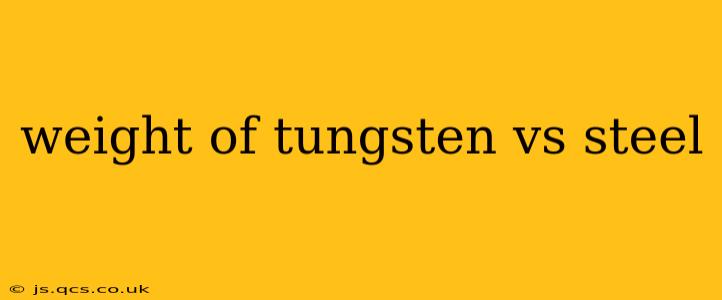Tungsten and steel are both incredibly strong and durable materials, frequently used in demanding applications. However, a key difference lies in their density—tungsten is significantly heavier than steel. Understanding this weight disparity is crucial for selecting the appropriate material for a given application. This article delves into the specifics of tungsten's and steel's weight, exploring the reasons behind the difference and highlighting the implications for various industries.
What is the density of tungsten and steel?
The most straightforward way to compare the weight of tungsten and steel is by examining their density. Density is mass per unit volume, usually expressed in grams per cubic centimeter (g/cm³) or pounds per cubic foot (lbs/ft³).
-
Tungsten: Tungsten boasts an exceptionally high density, typically around 19.3 g/cm³ (or approximately 1200 lbs/ft³). This makes it one of the densest naturally occurring elements.
-
Steel: The density of steel varies depending on the alloying elements and grade. However, a common average density for steel is around 7.85 g/cm³ (or approximately 490 lbs/ft³).
This means that tungsten is roughly 2.5 times denser than steel. A given volume of tungsten will weigh 2.5 times more than the same volume of steel.
Why is tungsten so much heavier than steel?
The significant difference in density stems from the atomic structure and properties of the two materials.
-
Tungsten's Atomic Structure: Tungsten atoms are considerably heavier than the atoms that make up steel (primarily iron, carbon, and sometimes other elements). This inherent atomic weight contributes significantly to its overall density.
-
Steel's Composition: Steel is an alloy—a mixture of iron and other elements. The addition of these elements alters the density slightly, depending on the specific composition. However, even the densest steels remain considerably less dense than pure tungsten.
What are the practical implications of this weight difference?
The substantial weight difference between tungsten and steel has significant implications across numerous applications:
-
Counterweights: Tungsten's high density makes it ideal for applications requiring compact, heavy counterweights. This is often seen in aircraft control systems and other precision engineering.
-
Radiation Shielding: Tungsten's high density also means it's effective at shielding against radiation. It's used in medical imaging equipment and nuclear applications.
-
Military Applications: Tungsten's weight and hardness contribute to its use in kinetic energy penetrators and other military hardware.
-
Sporting Goods: In some niche sporting goods, like some golf club heads, tungsten is used to create a precise center of gravity for better performance. However, the significant weight often limits broader adoption.
-
Cost: Tungsten is significantly more expensive than steel, limiting its use to applications where its unique properties justify the cost.
How does the weight affect machining and manufacturing?
The high density of tungsten presents challenges during machining and manufacturing:
-
Increased Tool Wear: Machining tungsten requires specialized tools due to its hardness and abrasive nature. This increases tool wear and manufacturing costs.
-
Specialized Equipment: The weight of tungsten necessitates the use of robust machinery capable of handling its density.
What are some common uses for tungsten and steel?
Tungsten: Beyond the applications mentioned above, tungsten is also used in:
- Filaments in light bulbs
- Electrodes in welding
- High-temperature furnace elements
Steel: Steel, due to its versatility and relatively low cost, finds applications in countless areas, including:
- Construction
- Automotive manufacturing
- Tools and machinery
- Household appliances
Is tungsten stronger than steel?
While tungsten has a significantly higher density than steel, strength is a more complex property. While tungsten is incredibly hard, its brittleness limits its overall strength compared to many grades of steel, particularly ductile steels. Steel, in its various forms, offers a better combination of strength and ductility.
This comprehensive comparison highlights the key differences between the weight of tungsten and steel, underscoring the importance of considering density and material properties when selecting materials for specific applications. The choice between these two metals often comes down to a trade-off between density, strength, cost, and machinability.
